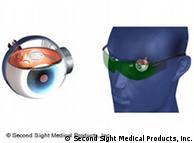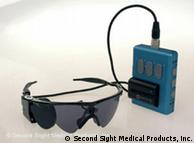Bionic eye helps the blind enter new dimensions of sight
The American-made Argus implant ('bionic eye') restores partial vision
to those blinded by retinitis pigmentosa. The second generation of the
implant will hit the European market this summer.
Germany's national health care system has agreed to cover the
Argus, and the United Kingdom and France are likely to follow. With a
100,000 US dollar (70,000 euro) price tag, whether or not the implant
will be able to restore sight to tens of thousands of Europeans won't be
determined by the success of the product, but by the ability of the
manufacturer and medical community to convince other healthcare systems
to pay for it.
 Argus II: Special glasses, a computer, and a chip implanted into the eye Argus II: Special glasses, a computer, and a chip implanted into the eye
Officials are likely to have a hard time denying a blind person the
chance of partially restoring their sight. Terry Byland from Los Angeles
went blind in his forties. Standing outside the Riverside Braille Club,
east of Los Angeles, he says: "The first time I touched that door with
this cane I hit it right in the middle of the door each time. There was
no guess work about where I was going."
Terry Byland is a member of the lively Riverside Braille Club. Most
club members are well adjusted to life without sight. They gather on
Tuesdays for exercise, bingo and choir practice. Before losing his
sight, Terry sold machinery. Shortly after he was diagnosed with
retinitis pigmentosa, his eyesight disappeared, leaving him scared and
frustrated.
Eye works like a camera
In many ways, the eye operates like a camera. For those suffering
from retinitis pigmentosa, like Terry, seeing becomes impossible because
of deteriorating photoreceptors in the retina - the equivalent of
having a layer of camera film missing. The light enters through the lens
and illuminates the film or the retina and transmits the picture of the
outside world to the brain.
The Argus, the artificial retina, communicates with the brain through
electric impulses, just like a full functioning retina would. A small
video camera attached to a pair of glasses sends its picture to a
computer the size of a deck of cards in the user's pocket. The computer
translates the image into electric impulses and wirelessly communicates
the information to electrodes implanted on the back of the eye.
The result is a highly-pixelated black and white picture. "Describing
what they see is very challenging. But what we can do is measure their
performance on tasks," explains Brian Mech of Second Sight Medical
Products in Los Angeles. He has been a leader on the Argus development
team for over a decade. "They can tell if people are approaching or
leaving, into what direction they are moving."
Enhanced features
Terry Byland was one of two patients to receive the first generation
of the implant during the earliest of the clinical trails. His feedback
allowed for the following version to be enhanced, and new features were
added. "I'd give anything to have the new version, but the FDA won't
allow that," says Byland.
 Our eye works like a camera. People blinded by retinitis pigmentosa lack a layer of film, so to speak Our eye works like a camera. People blinded by retinitis pigmentosa lack a layer of film, so to speak
The American FDA, or Food and Drug Administration, has yet to give
the green light to the Argus, even though European health officials have
already granted approval. The FDA is notoriously tough, but all in the
name of safety. Others, particularly those holding the purse strings,
have a different set of questions. For example, how much will the
implant affect the lifestyles of those who receive it?
Terry Byland does not wear his glasses everywhere. For instance he
points out, they don't work properly inside the Riverside Braille Club.
"I've had them here before," he says, "and the contrast value here is
lousy. What I mean by that is you walk in there and it is mostly all
vanilla. There's not that much dark and light to work with. And without
that the camera doesn't work that well."
People like Terry Byland who have been blind for a long time already
have ways to compensate, like listening for the traffic of cars to stay
in the lines of a pedestrian crossing. On the other hand, those who have
recently lost their sight might not be so good at these new skills and
may find the implant very useful.
Mind meets machine
The next generations of bionic eye might be different. The Argus II
currently has 60 electrodes, but the team is hoping to develop that
further eventually produce an implant with around two thousand
electrodes. Adding electrodes is similar to adding pixels to a digital
camera - more pixels means a better image.
 The Argus II computer is not bigger than a deck of cards The Argus II computer is not bigger than a deck of cards
But there's a limit: "It turns out that God or nature is a much
better engineer than man," warns Mech of Second Sight Medical Products,
referring to the human eye. "At least when it comes to this part,
because we could never build electrodes that are as efficient as our
photodetectors."
While the Argus is an improvement, it has its technological
limitations and is only applicable to a certain group of visually
impaired. Since it's people with retinitis pigmentosa who are only
approved to receive the device, Argus candidates make up a small
fraction of those with advanced vision loss.
The real technological feat of this device is often overlooked,
however. It's the first machine that interfaces directly with the brain
to be made available to the public. So while possibilities of restoring
sight may be limited, the possibilities of mind meets machine are
something to look forward to.
Author: Annie Gilbertson
Editor: Guy Degen
http://www.dw-world.de/dw/article/0,,14989409,00.html
| 








